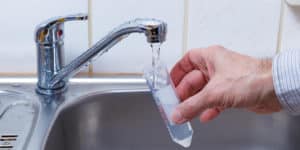The U.S. Environmental Protection Agency’s (EPA) rules that protect public drinking water systems do not apply to individual or privately-owned water systems. If you are an individual water system owner, it’s up to you to test your water to ensure that it’s safe to use and consume. A water test will indicate the safety of your water, but only if you know how to interpret it. Keep reading to learn more about what a water test shows.
General Indicators
General water quality indicators are parameters used to determine the possible presence of harmful contaminants. Most general water tests will give you the information you need so you can avoid costly tests for specific contaminants. Here are some of the most common water quality indicators and what an acceptable limit of them are:
Coliform Bacteria
Water tests will look for coliform bacteria, which is possible bacterial or viral contamination (absent) from human sewage or animal waste. An acceptable number to see on your water test is anything less than 1 coliform/100ml.
pH Value
The pH value of water is a measure of your water’s overall health. Water with too high of a pH can make your water feel slippery or have a soda taste. Water with too low a pH will cause pitting of pipes and fixtures, as well as a metallic taste. An acceptable range for pH values is between 6.5 to 8.5.
Total Dissolved Solids (TDS)
Testing for Total dissolved solids (TDS) looks for any signs of dissolved minerals like iron or manganese. High TDS can indicate hardness and cause staining or salty, bitter-tasting water. If your water report says anything other than 500 mg/L for TDS, it’s time to look for a professional plumber to resolve the problem.
Nuisance Contaminants
Nuisance contaminants are another category of contaminants. Although they don’t have adverse health effects at low levels, they can make water unsuitable for many household purposes. Here are some typical nuisance contaminants you may see on your water report and their acceptable limits, according to the EPA Secondary Drinking Water Standards.
- Chlorides: 250 mg/L
- Copper (Cu): 1.0 mg/L
- Iron (Fe): 0.3/mg/L
- Manganese (Mn): 0.05 mg/L
- Sulfates (SO4) 250 mg/L
Hardness
Hardness is another contaminant you may see on a water test report. Hard water causes white, scaly deposits on plumbing fixtures and cooking appliances and affects the effectiveness of soaps and detergents. On a water test report, hardness will be expressed in either milligram per liter (mg/L) or grains per gallon (gpg). Here are what the concentration of hardness on a water report are and what they mean.
- Below 3.5 gpg or 60 mg/L = soft water
- Between 3.5 to 7.0 gpg or 60 to 120 mg/L = moderately hard water
- Between 7.0 to 10.5 gpg or 120 to 180 mg/L = hard water
- 10.5 and above gpg or 180 and above mg/L = very hard water
If your water test shows that your property has hard water, be sure to enlist the help of a professional plumber before hard water affects your daily activities.
Get Clear and Concise Results from Michael Runk Plumbing and Heating
One of the best ways to interpret a water test is to have a professional plumber test your water for you. Here at Michael Runk Plumbing and Heating, we can test your water for you, clearly explain the results, and work with you to create a plan to maintain or repair your plumbing system. Contact us now to get started.

